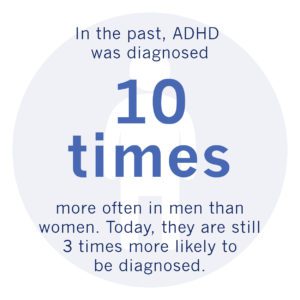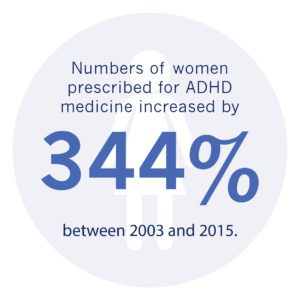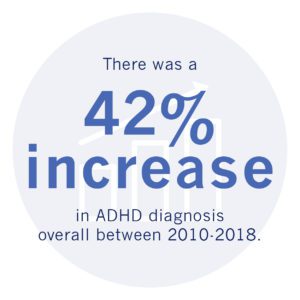“I’m falling apart, and I don’t know why.”
Martine Veien Soernskog, digital content manager and Ph.D. candidate in Business Psychology at The Chicago School, repeats the words she’s heard over and over again from women who are struggling just as she has: I’m falling apart, and I don’t know why.
“We need someone to validate that feeling is real,” Soernskog continues. “It’s not that we didn’t get enough sleep or don’t know the information or that we don’t want to. It’s just that we can’t. But what happens when we say that? How is it received?”
Soernskog was diagnosed with attention deficit hyperactivity disorder, or ADHD, at age 27, after years of frustration and stress, wondering why she had more difficulty with some tasks than others. For her, receiving the diagnosis was more of a relief than a setback, because finally, she had that verification so many women have yet to receive. What she was feeling was real; there was a reason for her difficulties, and with it identified, she could move forward with heightened empowerment through understanding.
 Unfortunately, many other women struggling around the U.S. at this very moment have yet to receive their validation. For decades, ADHD in women was thought to be virtually nonexistent, with men being diagnosed 10 times more often than women. However, as research has advanced, this assumption has been proven false. Between 2003 and 2011, the U.S. saw a greater increase in ADHD among females (55%) than among males (40%), according to a 2015 study published in the Journal of Clinical Psychiatry.
Unfortunately, many other women struggling around the U.S. at this very moment have yet to receive their validation. For decades, ADHD in women was thought to be virtually nonexistent, with men being diagnosed 10 times more often than women. However, as research has advanced, this assumption has been proven false. Between 2003 and 2011, the U.S. saw a greater increase in ADHD among females (55%) than among males (40%), according to a 2015 study published in the Journal of Clinical Psychiatry.
While these numbers show that awareness and acknowledgment of ADHD in women have improved over the past few decades, some misconceptions persist, leaving a large number of women with the disorder to go undiagnosed until later in life, if ever. And despite the view some still hold that ADHD is a minor or nonexistent disorder, it can have serious effects on the lives of people with ADHD, especially when undiagnosed—potentially leading to tragic outcomes.
Granting all women and individuals struggling with undiagnosed ADHD the same validation Soernskog found could go a long way to mitigate tragedy. However, for this to happen, common perceptions about ADHD and its presentation in individuals need to shift drastically to be more accurate for women and the community in general.
The truth about ADHD
The misconceptions held for decades in the fields of psychology and psychiatry about ADHD, a disorder more historically observed by how symptoms impact others rather than the individual, have led to much of the lasting harm affecting undiagnosed individuals.
Department chair of Marriage and Family Therapy at the California campuses of The Chicago School, Josh Wyner, Ph.D., recalls sentiments from Russell A. Barkley, Ph.D., a leading researcher in ADHD and a major influence in Dr. Wyner’s own studies of the disorder.
“In Barkley’s work, he points out that by naming it ‘ADHD,’ we’re characterizing the condition by two potential, but not guaranteed, symptoms that are observed externally,” Dr. Wyner says. In reality, ADHD is far more efficiently defined by the differences in temporal and emotional processing found in ADHD brains.
Soernskog recalls how the misconception influenced her as well. “I also believed that ADHD is something external, but it’s not. It has everything to do with your internal processing system,” she explains. “I think of myself as a computer sometimes; I just never knew that the way my computer translates information is different than other people’s.”
The cause of ADHD is unknown but its physical existence in the human brain has now been observed beyond symptom manifestations. Studies using neuroimaging technology have observed that structures in the ADHD brain have small but significant volume differences when compared with the non-ADHD brain across multiple major brain structures.
It also produces less norepinephrine, a neurotransmitter directly linked to dopamine, which affects motivation and reward responses. The reduced volume of ADHD brains does not affect intelligence in ADHD individuals; however, it can lead to other cognitive issues.
Cognition is emotional first, with intellect acting as a secondary factor in decision-making. Our choices come out of our initial emotions or emotional associations when presented with situations new and old, and intellect comes second.
“In everyday life, neurotypical people can quickly assess situations with their emotions and use them to identify which choices to make to most effectively accomplish tasks or reach goals. They’re very connected to the emotional importance of each choice,” Dr. Wyner explains. “However, the areas of the brain that don’t seem to fire as strongly in ADHD individuals compared to neurotypical individuals are the same areas of the brain that connect emotional importance to different events.”
These weakened connections in the brain affect memory as well as daily function because memory is dependent on emotion to determine what information is important to keep.
“What happens for the ADHD person is if something wasn’t as important to them, they tend not to store the memory as strongly as a neurotypical person. So now you have memory deficits showing up, where important information that the ADHD individual didn’t develop a strong emotional tag for may have accidentally been flagged as unimportant and thrown away,” Dr. Wyner says.
ADHD individuals also experience what Dr. Barkley refers to it as “temporal myopia,” a nearsightedness in time that occurs due to downregulated emotional processing. According to Dr. Barkley, “the [ADHD] individual’s behavior is governed even more than normal by events close to or within the temporal now and immediate context rather than by internal information that pertains to long-term results or future events.”
Developmental differences in ADHD brains often result in the symptoms the disorder was named for, but their actual cause lies in the ADHD brain’s difficulty linking emotion to memory, and therefore its weakened prioritization abilities.
“Inattention and hyperactivity are the exact same thing. They’re two different reactions to the same situation of having many choices that seem equally important at once,” Dr. Wyner says. “If the reaction to that is to shut down, it gets classified as inattentive. If the reaction is to try to react to all at once, it gets classified as hyperactive.”
 According to Soernskog’s research, the misconception that more boys have ADHD than girls is due to limited or inaccurate data. Studies have proven that gender bias in medical research has led to misunderstandings of the ways women present multiple different physical and mental conditions, leaving women at a disadvantage in receiving diagnoses and treatment. This is compounded upon for women of color, who face additional issues through the interference of racial bias in medicine.
According to Soernskog’s research, the misconception that more boys have ADHD than girls is due to limited or inaccurate data. Studies have proven that gender bias in medical research has led to misunderstandings of the ways women present multiple different physical and mental conditions, leaving women at a disadvantage in receiving diagnoses and treatment. This is compounded upon for women of color, who face additional issues through the interference of racial bias in medicine.
“We’re still working with research that was done 40, 50 years ago,” Soernskog says. “But think about how different the field of psychology looked back then in terms of who did the research and who had the jobs. More people now are in settings that can allow them to ask questions, but we’re still missing some valuable information.”
Disproportionate effects on women
Though the misconceptions about ADHD and its manifestation can negatively affect any individuals who present the disorder in a less-understood way, the medical research gender bias has led to it being disproportionately underdiagnosed in women.
 “As a woman who was diagnosed with ADHD very late, I am shocked by how many girls say they can relate when I talk about my experience receiving a diagnosis as an adult, and how many other women also have essentially learned to mask and thrive with ADHD,” Soernskog says.
“As a woman who was diagnosed with ADHD very late, I am shocked by how many girls say they can relate when I talk about my experience receiving a diagnosis as an adult, and how many other women also have essentially learned to mask and thrive with ADHD,” Soernskog says.
Compulsion to mask, or keep symptoms internal, has been a significant factor in the underdiagnosis of ADHD in women.
“We need to recognize that, socially, we have gendered expectations that influence how people act. So more often, girls are going to exhibit what you might call the ‘internalizing’ symptoms because that’s what they’ve been socialized to believe is the more appropriate reaction,” Soernskog explains. “Meanwhile, boys are more likely to exhibit ‘hyperactivity’ because they’ve been encouraged to react externally from an early age. Girls can have external exhibitions of symptoms as well, they’re just often more likely to be reprimanded for it, so it’s more likely to manifest internally.”
But internalized symptoms don’t make life any easier on individuals with ADHD. More often, they just mean that the individual’s difficulties go unnoticed, or are blamed on other factors. As Soernskog puts it, “At least hyperactivity is something people can see. What they can’t see is when I feel hurt because my brain is translating the feedback being given to me as criticism and taking it personally. You can’t see my palms sweating or my nervous system running amok because I’m trying to make sure that I don’t act out on this feeling that may not actually be true.”
While some may be able to navigate life undiagnosed but manage their symptoms, many others are not as lucky. ADHD, especially when undiagnosed, can lead to substance abuse issues, self-destructive behavior, and suicide attempts.
“If you go through life without the help that can come with an official diagnosis, I think you take in the message that it really is your problem and that you’re broken,” Dr. Wyner says. “Outside of that if you don’t get help, especially in school, it can cause problems. I’ve seen long-term cases that are very sad.”
Expanding understanding
There still is a long way to go to make sure more people with internalized ADHD symptoms receive the diagnosis and support they desperately need. Continuing to expand research and deepen understanding of the disorder is vitally important to the long-term well-being of the ADHD community because presentation can vary so much between different individuals. ADHD brains may be wired differently than non-ADHD brains, but there are many other factors to who individuals with ADHD are as people and how the disorder affects their lives.
Dr. Wyner points to hopeful advancements in ADHD assessment.
“Continuing what Barkley has started in terms of learning how to better assess ADHD is always important. I know he released an updated questionnaire in one of his more recent books that doesn’t mention attention or hyperactivity at all. It’s all time-based, which I think is great. So, assessment is getting better, but it’s still not great because it remains largely symptom-based for most other questionnaires.”
 Expanding perceptions of ADHD within the general public can also help more cases get noticed and identified. Spreading facts to debunk the misconceptions can help to break down misunderstandings and stigma, as well as highlight more of the strengths often found in individuals with ADHD.
Expanding perceptions of ADHD within the general public can also help more cases get noticed and identified. Spreading facts to debunk the misconceptions can help to break down misunderstandings and stigma, as well as highlight more of the strengths often found in individuals with ADHD.
“I think of the careers I tend to see ADHD individuals go into. They’re great in formats where the job involves immediate action, then allows them to go home and not think about the job much until it’s time to return. It fits with an assortative style, and you wouldn’t want to convert someone like that into the other extreme because they wouldn’t be as effective in their work,” Dr. Wyner says.
With Dr. Wyner at the helm, the MFT department at The Chicago School teaches the most updated views on ADHD, empowering students to bring more accurate views of ADHD to the field to improve perceptions for the future.
Soernskog is hopeful about the future and the impact The Chicago School graduates can have on the ADHD community.
“The fact that The Chicago School is an institution where these conversations happen has such a massive snowballing effect, because people graduate as something more than just therapists,” she says. “They’re going to go out into communities to teach and tutor and help people to recognize and diagnose ADHD. These are neurodiverse professionals who are going to go out there and changing workplaces. They’re going to understand why we need to promote and accept different ways of learning and different ways of doing things to accommodate for people’s needs and abilities so they can become their best selves.”
To learn more about The Chicago School, fill out the form below.

